My First Mountain
When people are asked why they seek to conquer mountains, or challenge themselves in other agonizing ways, sometimes they struggle to put their feelings into words. Maybe it is the adrenaline rush, the drive to push one’s limits, the experience of something new, the opportunity for self-reflection, the oneness with nature, the connection to something bigger, or the feeling of accomplishment. When English mountaineer George Mallory, who made several attempts to be the first to reach the summit of Mount Everest in the 1920s, was asked by the New York Times why he wanted to climb the world’s tallest peak, he answered simply, “Because it is there.”
My reasons for climbing Mount Kilimanjaro, Africa’s highest peak and the world’s tallest free-standing mountain, were all of the above. I am a thrill seeker, enjoying rollercoasters and trying skydiving over the Palm islands in Dubai, where I live. I also particularly like athletic challenges and recently completed my fifth marathon. When my father-in-law, who is in his late sixties, decided he wanted to check Kilimanjaro off his bucket list and asked who would like to join him, I jumped at the chance.
At an elevation of 5,895 meters (19,341 feet) above sea level, Mount Kilimanjaro pales in comparison to Mount Everest’s 8,848 meters (29,029 feet). But goals must be reachable and Kilimanjaro suited me—and many others climbing their first mountain—just fine. Kilimanjaro attracts novices because it is a nontechnical hike, which means no ropes, no special equipment, and no prior experience are needed. Yet, it also attracts experts, because it is one of the “Seven Summits,” the highest mountains on each of the seven continents.
For me, the preparation for the climb was nearly as nerve-wracking as the climb itself. First, there was the gear. The temperatures on Kilimanjaro range from hot (21 to 27C) to bitter cold (–7 to –29C) as one climbs higher up, no matter what time of year it is. It is said that it is like traveling from the equator to Antarctica in a matter of days. We would be going to Kilimanjaro in February, which is outside of the rainy season, but there was still plenty of rainfall.
The key is layers. I went to a specialty store called Adventure HQ, where the salesperson dressed me in four layers on the bottom and six layers on top. I learned the difference between a windbreaker, a waterproof shell jacket, and an insulated down jacket, and why absolutely all of these would be needed for the trip. Every time I asked her, “Is this really necessary?” she would retort, “Do you want to freeze? Do you want your fingers to become so numb you can’t feel them?”
Then there was the physical preparation, which was not strenuous because I was already in good shape. The best way to prepare for hiking Kilimanjaro is to hike, and, above all, to break in one’s hiking boots. Because there are no mountains to climb in Dubai, I resorted to climbing the stairs in an office building. I did not appreciate the office workers smoking in the stairwells, but they looked at me like I was the crazy one.
Finally, there was the mental preparation. I fretted over what to pack, how I would deal with the cold and possibly altitude sickness, and even how it would feel not to take a shower for eight days. When I asked friends who had hiked Kilimanjaro for their advice, I got a treasure trove of tips, from sleeping with a hot water bottle to bringing plenty of baby wipes.
My father-in-law handled the rest of the logistics for me and my sister-in-law, Zouza, who would be joining us and is also in her thirties. He chose Ultimate Kilimanjaro as our guide and the Lemosho route, which takes longer than most of the other six routes, but offers a high summit success rate. Climbing too fast can lead to altitude sickness from a lack of oxygen, resulting in hyperventilation, nausea, and exhaustion. In any case, we decided to take a medication called Diamox, which helps prevent altitude sickness.
After arriving at our hotel in Moshi, we met a couple of our Tanzanian guides and the rest of our group of twelve. I discovered more reasons people climb mountains, namely to celebrate milestones. There were five American women, including two separate pairs of friends celebrating their fortieth birthdays. There was a Swedish couple celebrating twenty years together. There were also an Australian man, and a Swiss man, the oldest in the group at seventy-six, who were not necessarily celebrating anything, but seemed to both be relishing the freedom of having grown-up children.
To support our group, there was a staff of forty-one Tanzanian guides, porters, and cooks. While we were responsible for carrying our daypacks, the porters carried everything else and rushed ahead to set up our tents at camp. There was even one man dedicated to carrying our tented port-a-potty. Throughout the trek I was amazed as to how much weight these men would carry over their heads, sometimes while wearing sandals and T-shirts, while we were all obsessing over whether our shoes would give us blisters and whether our layers would keep us warm enough.
Day one began in the rainforest up dirt paths through dense trees, where we spotted a few monkeys. It had rained in the morning, but cleared up by the time we started our hike. It was warm enough to be comfortable in a T-shirt and pants. The first day’s hike was only around 2.5 hours, covering five kilometers. The hiking length and intensity would increase as the days passed, culminating in the summit night. The terrain, too, would change. We would go from rainforest to moorland to alpine desert to ice cap.
Upon reaching camp, we buddied up for our tents, had some nice hot drinks and snacks, and then measured our oxygen levels. My oxygen was 95. If it goes any lower than 70, it is considered too dangerous to continue and one must descend from the mountain. There was then time to socialize with the group, have dinner, and listen to the next day’s briefing from the head guides. The dinner of cucumber soup, fried tilapia, vegetables, and potatoes was surprisingly good, especially considering the cooks prepared it all on small portable propane stoves.
On day two we hiked for two hours in the rainforest and four hours in the moorland. The weather was very erratic and removing and adding layers became an art form. When it got hot, I removed my long-sleeved shirt and got out my sunglasses and hat. When it started pouring rain, I got out my rain jacket, waterproof pants, and daypack rain cover. One thing I neglected to do was take my camera out of my pocket, and at the end of the day I discovered that it had gotten soaked and stopped working. The extra camera battery and SD cards I had packed were useless, and I had to rely on others for pictures of the trip. Thankfully, there was no shortage of those.
The sun finally came out at camp and everyone took the opportunity to put their wet clothes out to dry. My father-in-law, who had made the mistake of wearing khakis that day, vowed to put his waterproof pants to good use from then on. At night, we could feel the temperature dropping, and it took a lot of willpower to get out of my sleeping bag, warmed with my hot water bottle, to use the bathroom. In the morning, though, we were rewarded with a magnificent, clear view of the snow-capped mountain. I said, “Wow,” out loud.
Day three continued through the moorland, which is dry land with little vegetation. Our adventure of the day was crossing a few streams by jumping from rock to rock. It rained in the last hour of our five-hour hike, but now we were getting used to that inevitability. By the time we reached the camp, it was pouring hard, accompanied by loud thunder and lightning. The guides told us that we might wake up to frost on our tents.
We woke up on day four not to frost but to the sound of our tent shaking violently from rough wind. Zouza and I decided it was time to start wearing thermal undershirts and pants, along with a fleece, a jacket, and gloves. As the wind howled, everyone seemed to be emerging from their tents in an anxious state, but the staff put us all in a good mood by performing a Kilimanjaro song, while we clapped along.
The hike that day was challenging and went up to Lava Tower at 4,600 meters, the highest point we would reach before summit day. The way to acclimatize the body properly is to “climb high, sleep low,” so we climbed for three hours up and then two hours slightly down to camp. The terrain was characterized by loose rocks and gravel, gradually turning into patches of snow. For once, it did not rain, but there were new obstacles to overcome. At some point, we had to hike down a high waterfall that was very slippery and narrow. I could tell that my father-in-law was beginning to get nervous and tired. Zouza and I were okay, but struggled with headaches from the high altitude.
We were relieved when we reached camp and even happier when we found a phone signal for the first time. With the help of a solar phone charger, we called home and I got to speak to my husband and kids. My middle son, who is seven, asked me, “Are you having fun at Kilimanjaro?” and “Are you finished climbing it yet?” He could not fathom that it would take so many days to climb one mountain.
The camp was at the base of a tall, rocky, vertical wall called the Barranco Wall. After dinner, the guides told us that the next day we would be partly using our hands to climb and that it would be best to not look down. Just before going to sleep, we said good night to my father-in-law, who said, “I’m not sure I will continue,” and shuffled off to his tent.
Zouza and I decided we needed to take action. We explained the situation to the head guide, who had the Tanzanian attitude of pole-ay, pole-ay (one step at a time) and hakuna matata (no worries). When we insisted that my father-in-law was, in fact, very worried, he said that stopping now would require an emergency evacuation. Instead, we came up with a plan to have a porter carry his daypack and a guide to accompany us at a slower pace than the rest of the group.
Day five felt like the point of no return. When we looked up at the wall, it looked extremely intimidating. There were dozens upon dozens of people climbing up, like a narrow, winding trail of ants. We took it very slow, one step at a time, reaching between rocks—right hand, left hand, right foot, left foot. There were times when we had to “kiss the rock,” holding on to the mountain sideways. It was not razor sharp to the edge, but it was quite close. If you fall, you would die, or at least get very badly injured.
It took around 2.5 hours to reach the top of the wall. Our guides were excellent and very patient. As we got closer, I could hear chanting from the rest of our group. “Go Mohammed, go, go Mohammed!” for my father-in-law, followed by chants for me and Zouza. The thoughtful gesture made me teary-eyed and happy that we had encouraged my father-in-law to continue.
The rest of the hike was completed above a thick layer of fluffy, cottonlike clouds, with the backdrop of a piercing blue sky. We arrived at camp with flushed faces from the sun, eager for some time to relax. My father-in-law seemed relieved that the Barranco Wall was over and that the summit felt within reach.
On the morning of day six we had a 3.5-hour hike to base camp. That night would be the big night. After lunch, we had a summit briefing, which made me nervous again about such things as how many layers to wear, what to do if my water freezes, and how to see if my headlamp battery dies. The plan was to sleep for a few hours, wake up at 10:30 p.m., have hot drinks and snacks at 11 p.m., and leave at 11:30 p.m.
I barely slept from 7 to 10:30 p.m., all the while feeling cold and panicky. Deciding what to wear was tricky, because one does not want to be cold, but it is also possible to wear too many layers and overheat, which results in sweating and then feeling cold. I ended up wearing three layers on the bottom, five layers on top, as well as two pairs of socks, two pairs of gloves, a balaclava, and a beanie.
It was pitch black, except for a line of lights zigzagging all the way up the mountain, as far as we could see. A girl from our group had given us each glow sticks that we hung from our backpacks, which helped distinguish our group from the crowds. The plan was to stick together, but my father-in-law had told us earlier that day in a very serious voice, “Girls, I may not make it to the top, so I don’t want you to stay with me.”
The hike was very tough: steep, dark, cold, and long. Because of the altitude, it felt like we were moving in slow motion, yet I was constantly panting and out of breath. My father-in-law separated from us quite early on during a very rocky portion. As time went on, Zouza and I started to worry whether this climb was just too strenuous for him and, if so, hoped that he would turn back. Meanwhile, we tried to stay motivated, making a plan for when to eat snacks and when to listen to music.
I did get headaches, but Advil relieved them. My headlight batteries did die, but Zouza’s was bothering her, so she gave me hers. I managed to keep my water bottle from freezing by filling it with boiling water, putting it upside down, and wrapping it in a ski sock, which worked until we reached Stella Point, one hour away from the top, at 5:40 a.m.
The last hour to Uhuru Peak was magical: the glaciers of snow set against the sunrise, the muffled quiet interrupted only by the sound of heavy breathing, and the steady footsteps reaching toward a point floating in boundlessness. When we finally got to the top, it was a bittersweet moment. The eleven that made it gave each other hugs and congratulations, but we were also sad my father-in-law was not with us. “I wish he was here to celebrate this moment,” Zouza said, as she tried to hold back her tears. “He should have been here.”
I tried to comfort her, but I was also crying. “We are both emotional and tired,” I said. “He would be happy and proud that we at least made it.”
We dried our tears and took pictures with the summit sign. Then we prepared to go back down again. The guides seemed to be in a big hurry to get us down, saying that it is dangerous to stay too long at high altitude.
As we started walking down, in a made-for-the-movies moment, we saw my father-in-law making his way up. We could not believe our eyes, and there was a flurry of hugs and tears as we realized it was indeed him. We were shocked, not only that he had made it, but that he had made it only about fifteen minutes after us. In a rare exception, the guides allowed us to go back to the sign to take more pictures.
After reaching the summit, we still had a long way to go. By that time my back was hurting from carrying my daypack, so when a guide offered to carry it for me, I gladly accepted. The way down was mostly loose gravel, making it very slippery and hard on the knees.
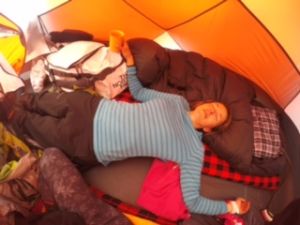
After 11 hours of hiking and no sleep, I was thoroughly exhausted (day 7). Photo by Gazbeya El Hamamsy..
At 10:45 a.m. I stumbled into our tent and immediately collapsed on top of my sleeping bag. The bad news was that we had little time to rest. We were told to be packed by 11:30 a.m., ready for a quick lunch of vegetable soup and jam sandwiches at noon, and then on to a four-hour hike down to the next camp.
That four-hour hike was torture. We had already hiked for eleven hours by that time, with no sleep. I was exhausted, and my feet and knees were hurting (even as a marathon runner). But there was no choice, so I popped another Advil and devoured a Snickers bar and carried on.
After we arrived at camp at 5 p.m., we had dinner and celebrated our summit success, as well as the birthdays in the group (complete with a frosted birthday cake, somehow baked without an oven). I went to sleep at 8 p.m. in a savasana (corpse pose). I do not think I moved until the next morning at 6:30 a.m. when we got our usual wake-up call, “Hell-O! Jambo, jambo! Time to finalize packing! Breakfast ready!”
As one of the guides said, “You’re not finished until you make it to the top and you make it to the bottom.” On day eight, we had our final hike, an easy 2.5 hours, down to the exit gate. We were back in light clothing, trekking through the rainforest. My feet were wrapped in Leukotape, my nose was sunburnt, my lips were chapped, and my eyes were puffy, but these were all badges of honor when we made it to the finish line.
I think the important thing about doing something for the first time is accomplishing it. That is probably why mountain climber Mallory kept attempting to reach the summit at Everest. And that is also why my father-in-law did not give up. Would I climb Kilimanjaro again? No—but only because it would no longer be a first.


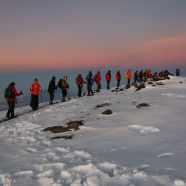





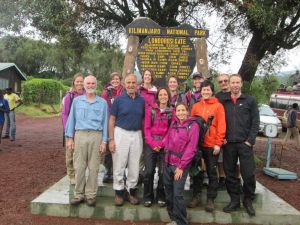
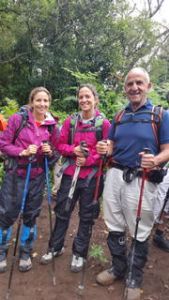
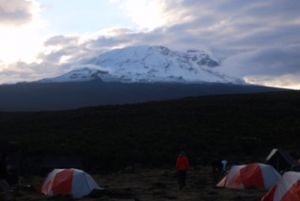
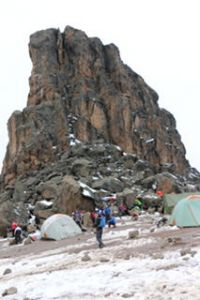
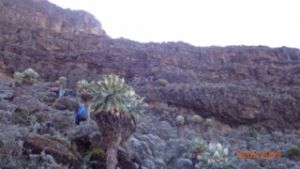
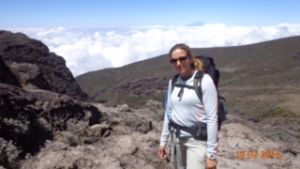
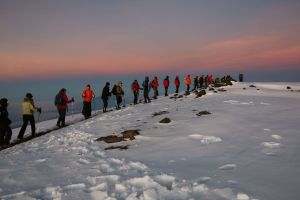
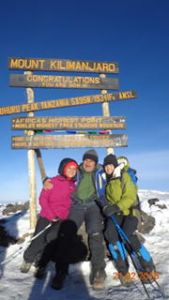
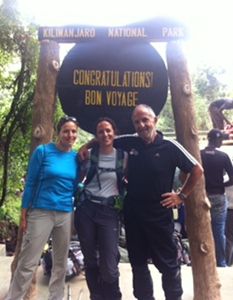
This is a wonderful story, and I’m happy the climb was so memorable for you! I